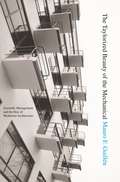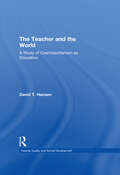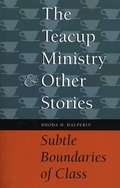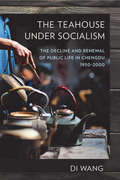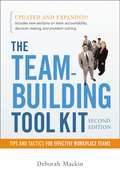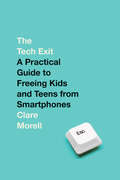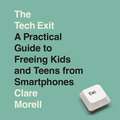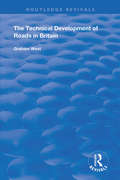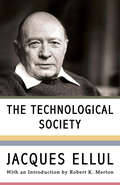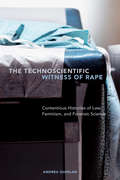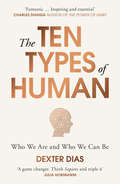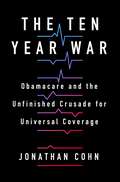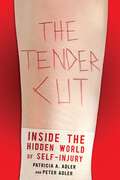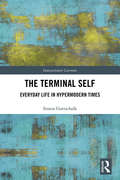- Table View
- List View
The Taylorized Beauty of the Mechanical: Scientific Management and the Rise of Modernist Architecture (Princeton Studies in Cultural Sociology #10)
by Mauro F. GuillénThe dream of scientific management was a rationalized machine world where life would approach the perfection of an assembly line. But since its early twentieth-century peak this dream has come to seem a dehumanizing nightmare. Henry Ford's assembly lines turned out a quarter of a million cars in 1914, but all of them were black. Forgotten has been the unparalleled new aesthetic beauty once seen in the ideas of Ford and scientific management pioneer Frederick Winslow Taylor. In The Taylorized Beauty of the Mechanical, Mauro Guillén recovers this history and retells the story of the emergence of modernist architecture as a romance with the ideas of scientific management--one that permanently reshaped the profession of architecture. Modernist architecture's pioneers, Guillén shows, found in scientific management the promise of a new, functional, machine-like--and beautiful--architecture, and the prospect of a new role for the architect as technical professional and social reformer. Taylor and Ford had a signal influence on Bauhaus founder Walter Gropius and on Le Corbusier and his Towards a New Architecture, the most important manifesto of modernist architecture. Architects were so enamored with the ideas of scientific management that they adopted them even when there was no functional advantage to do so. Not a traditional architectural history but rather a sociological study of the profession of architecture during its early modernist period, The Taylorized Beauty of the Mechanical provides a new understanding of the degree to which modernist architecture emerged from a tradition of engineering and industrial management.
The Teacher Toolbox for a Calm and Connected Classroom: Teacher-Friendly Mental Health Strategies to Help You and Your Students Thrive
by Joanna SchwartzThe Teacher Toolbox for a Calm and Connected Classroom is a whole-child, whole-hearted approach to teaching, wellness, and student--teacher relationships.Chock-full of practical advice and brain-based tools from an experienced teacher and counselor, this book solves the question of how psychology and education can enrich and empower both teachers and students' wellness. Peppered with relatable anecdotes from the authors' experiences, the book deals with how to help unpack the' "invisible backpack" that both teachers and students bring into the classroom. Chapters are broken down to show how to practically address common issues such challenging behavior, social-emotional learning, trauma-informed education, attachment theory, mindfulness, mental health and much more. Each chapter outlines these common challenges but also provides an abundance of practical tools that can be used to help. Written accessibly, and with tools which are easy to implement, The Teacher Toolbox for a Calm and Connected Classroom is an indispensable guide for any teacher.
The Teacher and the Teenage Brain
by John ColemanThe Teacher and the Teenage Brain is essential reading for all teachers and students of education. This book offers a fascinating introduction to teenage brain development and shows how this knowledge has changed the way we understand young people. It provides a critical insight into strategies for improving relationships in the classroom and helping both adults and teenagers cope better with this stage of life. Dr John Coleman shows how teachers and students can contribute to healthy brain development. The book includes information about memory and learning, as well as guidance on motivation and the management of stress. Underpinned by his extensive work with schools, Dr Coleman offers advice on key topics including the importance of sleep, the social brain, moodiness, risk and risk-taking and the role of hormones. This book is extensively illustrated with examples from classrooms and interviews with teachers. It explicitly links research and practice to create a comprehensive, accessible guide to new knowledge about teenage brain development and its importance for education. Accompanied by a website providing resources for running workshops with teachers and parents, as well as an outline of a lesson plan for students, The Teacher and the Teenage Brain offers an innovative approach to the understanding of the teenage brain. This book represents an important contribution to teacher training and to the enhancement of learning in the classroom.
The Teacher and the World: A Study of Cosmopolitanism as Education (Teacher Quality and School Development)
by David T. HansenWinner of the 2013 American Educational Studies Association's 2013 Critics Choice Award! Teachers the world over are seeking creative ways to respond to the problems and possibilities generated by globalization. Many of them work with children and youth from increasingly varied backgrounds, with diverse needs and capabilities. Others work with homogeneous populations and yet are aware that their students will encounter many cultural changes in their lifetimes. All struggle with the contemporary conditions of teaching: endless top-down measures to manipulate what they do, rapid economic turns and inequality in supportive resources that affect their lives and those of their students, a torrent of media stimuli that distract educational focus, and growth as well as shifts in population. In The Teacher and the World, David T. Hansen provides teachers with a way to reconstruct their philosophies of education in light of these conditions. He describes an orientation toward education that can help them to address both the challenges and opportunities thrown their way by a globalized world. Hansen builds his approach around cosmopolitanism, an ancient idea with an ever-present and ever-beautiful meaning for educators. The idea pivots around educating for what the author calls reflective openness to new people and new ideas, and reflective loyalty toward local values, interests, and commitments. The book shows how this orientation applies to teachers at all levels of the system, from primary through university. Hansen deploys many examples to illustrate how its core value, a balance of reflective openness to the new and reflective loyalty to the known, can be cultivated while teaching different subjects in different kinds of settings. The author draws widely on the work of educators, scholars in the humanities and social sciences, novelists, artists, travellers and others from both the present and past, as well as from around the world. These diverse figures illuminate the promise in a cosmopolitan outlook on education in our time. In this pioneering book, Hansen has provided teachers, heads of school, teacher educators, researchers, and policy-makers a generative way to respond creatively to the pressure and the promise of a globalizing world.
The Teacher's Guide to Resolving School Bullying: Evidence-Based Strategies and Pupil-Led Interventions
by Elizabeth NassemDrawing on the author's cutting-edge research this practical book helps teachers better understand the causes of bullying, gives them confidence to resolve nuanced cases, and provides them with the tools to develop pupil-led anti-bullying campaigns. This book delves into the complex nature of bullying at school in a clear and approachable way. It helps school staff understand the student's views and experiences of bullying, and how power imbalances and systemic inequalities can contribute to bullying relationships between pupils. The author provides evidence-based interventions that suggest ways teachers can develop knowledge and skills to resolve incidents. Key to this is a new approach to pupil-led interventions which allows staff to harness pupil voices to develop effective anti-bullying strategies. Included are resources and tools to help teachers set up these advisory groups and interventions, and train others to do the same. This is essential reading for teachers looking for a comprehensive and accessible guide to tackling bullying.
The Teacher: Theory and Practice in Teacher Education (Routledge Library Editions: Philosophy of Education #15)
by Allen T. PearsonIt is widely agreed that teacher education must consist of two general components. There is a knowledge component which contains specialized subject matter knowledge, and a practical component in which intending teachers develop skills and abilities. In this original and compelling work, first published in 1989, Pearson attempts to examine the connection between the two. This title will be of interest to students of education.
The Teaching of Jesus and its Enduring Significance: With an Appendix: 'A Brief Description of the Christian Doctrine' (Primary Sources in Phenomenology)
by Franz BrentanoHere, for the first time in English, is Franz Brentano’s The Teaching of Jesus, a compendium of texts Brentano assembled for publication shortly before his death that constitute a frank, public settling of accounts with the Christian religion. Originally conceived by Brentano as a volume that might help others similarly led to doubt the doctrines of Christianity, the book is remarkably free of bitterness or spitefulness. On the contrary, what makes the book of singular importance, especially now, is its careful attempt at taking stock of the positive and negative influence Christianity has had in history. This text appeals to those researchers and scholars interested in the work of Franz Brentano and his work on the philosophy of religion, in this case, Christianity.
The Teacup Ministry & Other Stories: Subtle Boundaries of Class
by Rhoda H. HalperinIn the global world of the twenty-first century, class boundaries are subtle and permeable, though real nonetheless. Markers of identity, authenticity, and belonging can change with a gesture or a glance, making people feel they do or don't belong in certain places, with certain people, at certain times. In these powerfully written ethnographic stories, Rhoda Halperin maps the boundaries of class by examining three themes: crossing class boundaries, class creativity, and class vulnerability. In telling these stories, Halperin draws on a wealth of ethnographic experiences in this country and abroad. Her book challenges class stereotypes in ways that touch on universals across cultures and over time. Rhoda H. Halperin is Professor of Anthropology at the University of Cincinnati. Her previous books include Practicing Community: Class Culture and Power in an Urban Neighborhood, Cultural Economies Past and Present, and The Livelihood
The Teahouse under Socialism: The Decline and Renewal of Public Life in Chengdu, 1950–2000
by Di WangTo understand a city fully, writes Di Wang, we must observe its most basic units of social life. In The Teahouse under Socialism, Wang does just that, arguing that the teahouses of Chengdu, the capital of Sichuan Province, are some of the most important public spaces—perfect sites for examining the social and economic activities of everyday Chinese.Wang looks at the transformation of these teahouses from private businesses to collective ownership and how state policy and the proprietors’ response to it changed the overall economic and social structure of the city. He uses this transformation to illuminate broader trends in China’s urban public life from 1950 through the end of the Cultural Revolution and into the post-Mao reform era. In doing so, The Teahouse under Socialism charts the fluctuations in fortune of this ancient cultural institution and analyzes how it survived, and even thrived, under bleak conditions.Throughout, Wang asks such questions as: Why and how did state power intervene in the operation of small businesses? How was "socialist entertainment" established in a local society? How did the well-known waves of political contestation and struggle in China change Chengdu’s teahouses and public life? In the end, Wang argues, the answers to such questions enhance our understanding of public life and political culture in the Communist state.
The Team-Building Tool Kit: Tips and Tactics for Effective Workplace Teams
by Deborah MackinThis helpful guide provides practical advice to guide team coaches, leaders, and members to high-performance results.Workplace teams learn to function as effective units when they have the tools and techniques to be greater than the sum of their parts. Filled with bullet points to make tips and strategies quick and easy to grasp, this book covers both the structure and nitty-gritty process details that so often derail even the best teams.In The Team-Building Tool Kit, you will learn how to:have effective team meetingsimprove accountability for results and team member behaviorassess team performanceresolve team conflictsrecognize the pitfalls that affect decision makingtrain for high performancedesign a plan for implementation Featuring new sections on team accountability, decision making, and problem solving, The Team-Building Tool Kit is a must-have for every team library.
The Tech Exit: A Practical Guide to Freeing Kids and Teens from Smartphones
by Clare MorellA road map to free your kids from the harms of digital technology and to recover the beauty, wonder, and true purpose of childhood—by a leading tech policy expert&“We know smartphones can be harmful to kids and teens, but what can we do about it? In this indispensable guide, Clare Morell documents the solutions that actually work.&”—Cal Newport, author of Slow Productivity and Digital MinimalismIt&’s no secret that addictive digital technologies like smartphones and social media apps are harming a generation of kids socially, mentally, and even physically. But a workable solution seems elusive. After all, don&’t kids need phones, and won&’t they be vulnerable or socially isolated without tech?Clare Morell, fellow at the Ethics and Public Policy Center and director of its Technology and Human Flourishing Project, argues that the answer is no. She exposes the lies parents have been sold about managing the dangers of tech through parental controls and screen-time limits, and demonstrates that another way is possible—even if your children are already using smartphones or social media.The Tech Exit maps a doable pathway to freedom from digital technology for families, local communities, and society. Drawing on dozens of interviews with experts and with families who have gone tech-free, as well as Morell&’s own work as a policy expert, The Tech Exit shows how digital technology is anything but necessary for children to live happy, healthy, and socially full lives.The Tech Exit is essential reading for any parent who has felt stuck between an awareness of the dangers of digital technology for kids and the feeling that tech is necessary and inevitable. Clare Morell&’s message is simple and compelling: You and your family can be free. The life you want for your children is within reach.
The Tech Exit: A Practical Guide to Freeing Kids and Teens from Smartphones
by Clare MorellIt's no secret that addictive digital technologies like smartphones and social media apps are harming a generation of kids socially, mentally, and even physically. But a workable solution seems elusive. After all, don't kids need phones, and won't they be vulnerable or socially isolated without tech?Clare Morell, fellow at the Ethics and Public Policy Center and director of its Technology and Human Flourishing Project, argues that the answer is 'no'. She exposes the lies parents have been sold about managing the dangers of tech through parental controls and screen-time limits, and demonstrates that another way is possible - even if your children are already using smartphones or social media.The Tech Exit maps a doable pathway to freedom from digital technology for families, local communities, and society. Drawing on dozens of interviews with experts and with families who have gone tech-free, as well as Morell's own work as a policy expert, The Tech Exit shows how digital technology is anything but necessary for children to live happy, healthy, and socially full lives.The Tech Exit is essential reading for any parent who has felt stuck between an awareness of the dangers of digital technology for kids and the feeling that tech is necessary and inevitable. Clare Morell's message is simple and compelling: You and your family can be free. The life you want for your children is within reach.
The Tech Exit: A Practical Guide to Freeing Kids and Teens from Smartphones
by Clare MorellIt's no secret that addictive digital technologies like smartphones and social media apps are harming a generation of kids socially, mentally, and even physically. But a workable solution seems elusive. After all, don't kids need phones, and won't they be vulnerable or socially isolated without tech?Clare Morell, fellow at the Ethics and Public Policy Center and director of its Technology and Human Flourishing Project, argues that the answer is 'no'. She exposes the lies parents have been sold about managing the dangers of tech through parental controls and screen-time limits, and demonstrates that another way is possible - even if your children are already using smartphones or social media.The Tech Exit maps a doable pathway to freedom from digital technology for families, local communities, and society. Drawing on dozens of interviews with experts and with families who have gone tech-free, as well as Morell's own work as a policy expert, The Tech Exit shows how digital technology is anything but necessary for children to live happy, healthy, and socially full lives.The Tech Exit is essential reading for any parent who has felt stuck between an awareness of the dangers of digital technology for kids and the feeling that tech is necessary and inevitable. Clare Morell's message is simple and compelling: You and your family can be free. The life you want for your children is within reach.
The Technical Development of Roads in Britain (Routledge Revivals)
by Graham WestThis title was first published in 2003. The history of roads in Great Britain has not been one of steady development, but rather, one that has waxed and waned in response to social, military and economic needs, and also as to whether there have been alternative methods of transport available. Paralleling this, the technical aspects of road construction - with the one great exception of Roman roads - can be seen as a fitful progression of improvement followed by neglect as the roadmaker has responded, albeit tardily on occasion, to the needs of the road user. This text describes the technical development of British roads in relation to the needs of the time, and thereby touches upon its relation to the history of the country more generally.
The Technological Society
by Jacques EllulAs insightful and wise today as it was when originally published in 1954, Jacques Ellul's The Technological Society has become a classic in its field, laying the groundwork for all other studies of technology and society that have followed. Ellul offers a penetrating analysis of our technological civilization, showing how technology—which began innocuously enough as a servant of humankind—threatens to overthrow humanity itself in its ongoing creation of an environment that meets its own ends. No conversation about the dangers of technology and its unavoidable effects on society can begin without a careful reading of this book. "A magnificent book . . . He goes through one human activity after another and shows how it has been technicized, rendered efficient, and diminished in the process.&”—Harper's &“One of the most important books of the second half of the twentieth-century. In it, Jacques Ellul convincingly demonstrates that technology, which we continue to conceptualize as the servant of man, will overthrow everything that prevents the internal logic of its development, including humanity itself—unless we take necessary steps to move human society out of the environment that 'technique' is creating to meet its own needs.&”—The Nation &“A description of the way in which technology has become completely autonomous and is in the process of taking over the traditional values of every society without exception, subverting and suppressing these values to produce at last a monolithic world culture in which all non-technological difference and variety are mere appearance.&”—Los Angeles Free Press
The Technologisation of the Social: A Political Anthropology of the Digital Machine (Contemporary Liminality)
by Paul O’Connor and Marius Ion BențaIn an era of digital revolution, artificial intelligence, big data and augmented reality, technology has shifted from being a tool of communication to a primary medium of experience and sociality. Some of the most basic human capacities are increasingly being outsourced to machines and we increasingly experience and interpret the world through digital interfaces, with machines becoming ever more ‘social’ beings. Social interaction and human perception are being reshaped in unprecedented ways. This book explores this technologisation of the social and the attendant penetration of permanent liminality into those aspects of the lifeworld where individuals had previously sought some kind of stability and meaning. Through a historical and anthropological examination of this phenomenon, it problematises the underlying logic of limitless technological expansion and our increasing inability to imagine either ourselves or our world in other than technological terms. Drawing on a variety of concepts from political anthropology, including liminality, the trickster, imitation, schismogenesis, participation, and the void, it interrogates the contemporary technological revolution in a manner that will be of interest to sociologists, social and anthropological theorists and scholars of science and technology studies with interests in the digital transformation of social life.
The Technology Acceptance Model: 30 Years of TAM (Human–Computer Interaction Series)
by Fred D. Davis Andrina GranićThis SpringerBrief discusses the origins, emergence, evolution, and future of the Technology Acceptance Model (TAM). TAM, simple yet powerful, has been extensively validated, standing as a leading scientific paradigm and a reliable model for explaining, predicting, and improving user acceptance across a spectrum of technological deployments. Over more than three decades since the introduction of TAM, numerous extensions have emerged, incorporating additional variables and collectively referred to as “TAM++”. However, perceived usefulness and perceived ease of use remain the basic beliefs of the core TAM model. The introductory chapter “Once upon a TAM” focuses on the challenging search for a user acceptance crystal ball, showing that it is indeed possible to consistently predict, explain, and improve user acceptance. “Evolution of TAM” traces the model's growth and adaptability, exploring the proliferation of selected TAM-related behavioural intention models, several integrated theoretical approaches, the quest for other behavioural intention antecedents, and TAM’s versatile applications in various contexts. “Revolution of TAM” presents an in-depth systematic review, encompassing a meta-analysis of selected TAM reviews and meta-analyses, and a narrative review of representative primary studies, providing a thorough and extensive understanding of the TAM universe. The epilogue “What will the Future of TAM be Like?” provides insights into its dynamic future. This SpringerBrief concludes with seven actionable principles, serving as a strategic guide for those aiming to customize the TAM++ body of knowledge for application-oriented studies within a particular context. This comprehensive overview of TAM is a valuable source of information for researchers, practitioners, and all interested readers, especially those new to the field.
The Technology of Policing: Crime Mapping, Information Technology, and the Rationality of Crime Control (New Perspectives in Crime, Deviance, and Law #4)
by Peter K. ManningWith the rise of surveillance technology in the last decade, police departments now have an array of sophisticated tools for tracking, monitoring, even predicting crime patterns. In particular crime mapping, a technique used by the police to monitor crime by the neighborhoods in their geographic regions, has become a regular and relied-upon feature of policing. Many claim that these technological developments played a role in the crime drop of the 1990s, and yet no study of these techniques and their relationship to everyday police work has been made available.Noted scholar Peter K. Manning spent six years observing three American police departments and two British constabularies in order to determine what effects these kinds of analytic tools have had on modern police management and practices. While modern technology allows the police to combat crime in sophisticated, detail-oriented ways, Manning discovers that police strategies and tactics have not been altogether transformed as perhaps would be expected. In The Technology of Policing, Manning untangles the varying kinds of complex crime-control rhetoric that underlie much of today’s police department discussion and management, and provides valuable insight into which are the most effective-and which may be harmful—in successfully tracking criminal behavior.The Technology of Policing offers a new understanding of the changing world of police departments and information technology’s significant and undeniable influence on crime management.
The Technoscientific Witness of Rape: Contentious Histories of Law, Feminism, and Forensic Science
by Andrea QuinlanIn 1984, the Sexual Assault Evidence Kit (SAEK) was dubbed "Ontario’s most successful rapist trap." Since then, the kit has become the key source of evidence in the investigation and prosecution of sexual assault as well as a symbol of victims’ improved access to care and justice. Unfortunately, the SAEK has failed to live up to these promises. The Technoscientific Witness of Rape is the first book to chart the thirty year history of the sexual assault evidence kit and its role in a criminal justice system that re-victimizes many assault victims in their quest for medical treatment and justice. Drawing on actor-network theory and feminist technology studies, Andrea Quinlan combs through sixty-two interviews with police, nurses, scientists, and lawyers, as well as archival records and legal cases to trace changes in sexual assault forensics, law, advocacy, and anti-violence activism in Ontario. Through this history Quinlan bravely and provocatively argues that the SAEK reflects and reinforces the criminal justice system’s distrust of sexual assault victims.
The Ten Faces of Innovation: IDEO's Strategies for Beating the Devil's Advocate and Driving Creativity Throughout Your Organization
by Jonathan Littman Tom KelleyThe author of the bestselling The Art of Innovation reveals the strategies IDEO, the world-famous design firm, uses to foster innovative thinking throughout an organization and overcome the naysayers who stifle creativity. The role of the devil's advocate is nearly universal in business today. It allows individuals to step outside themselves and raise questions and concerns that effectively kill new projects and ideas, while claiming no personal responsibility. Nothing is more potent in stifling innovation. Over the years, IDEO has developed ten roles people can play in an organization to foster innovation and new ideas while offering an effective counter to naysayers. Among these approaches are the Anthropologist—the person who goes into the field to see how customers use and respond to products, to come up with new innovations; the Cross-pollinator who mixes and matches ideas, people, and technology to create new ideas that can drive growth; and the Hurdler, who instantly looks for ways to overcome the limits and challenges to any situation. Filled with engaging stories of how Kraft, Procter and Gamble, Safeway and the Mayo Clinic have incorporated IDEO's thinking to transform the customer experience, The Ten Faces of Innovation is an extraordinary guide to nurturing and sustaining a culture of continuous innovation and renewal.
The Ten Types of Human: A New Understanding of Who We Are, and Who We Can Be
by Dexter DiasThe inspiration behind the hit podcast THE 100 TYPES OF HUMAN with DEXTER DIAS and BBC 5 Live host NIHAL ARTHANAYAKE'This book is the one. Think Sapiens and triple it.' - Julia Hobsbawm, author of Fully Connected_______________________________We all have ten types of human in our head.They're the people we become when we face life's most difficult decisions. We want to believe there are things we would always do - or things we never would. But how can we be sure? What are our limits? Do we have limits? The Ten Types of Human is a pioneering examination of human nature. It looks at the best and worst that human beings are capable of, and asks why. It explores the frontiers of the human experience, uncovering the forces that shape our thoughts and actions in extreme situations.From courtrooms to civil wars, from Columbus to child soldiers, Dexter Dias takes us on a globe-spanning journey in search of answers, touching on the lives of some truly exceptional people.Combining cutting-edge neuroscience, social psychology and human rights research, The Ten Types of Human is a provocative map to our hidden selves. It provides a new understanding of who we are - and who we can be._______________________________'The Ten Types of Human is a fantastic piece of non-fiction, mixing astonishing real-life cases with the latest scientific research to provide a guide to who we really are. It's inspiring and essential.' - Charles Duhigg, author of The Power of Habit'I emerged from this book feeling better about almost everything... a mosaic of faces building into this extraordinary portrait of our species.' - Guardian'Uplifting and indispensable.' - Howard Cunnell _______________________________What readers are saying about 'the most important book in years':'utterly compelling...this one comes with a warning - only pick it up if you can risk not putting it down' - Wendy Heydorn on Amazon, 5 stars'one of the most remarkable books I've read... I can genuinely say that it has changed the way I view the world' - David Jones on Amazon, 5 stars'Essential reading for anyone wishing to understand the human condition... a thrilling and beautifully crafted book' - Wasim on Amazon, 5 stars'This is the most important book I have read in years' - Natasha Geary on Amazon, 5 stars'an important and fascinating read... It will keep you glued to the page' - Hilary Burrage on Amazon, 5 stars'a journey that I will never forget, will always be grateful for, and I hope will help me question who I am... a work of genius' - Louise on Amazon, 5 stars'This is a magnificent book that will capture the interest of every type of reader... one of those rare and special books that demand rereading' - Amelia on Amazon, 5 stars 'I simply couldn't put it down... one of the most significant books of our time' - Jocelyne Quennell on Amazon, 5 stars'Read The Ten Types of Human and be prepared to fall in love' - Helen Fospero on Amazon, 5 stars
The Ten Year War: Obamacare and the Unfinished Crusade for Universal Coverage
by Jonathan CohnJonathan Cohn's The Ten Year War is the definitive account of the battle over Obamacare, based on interviews with sources who were in the room, from one of the nation's foremost healthcare journalists.The Affordable Care Act, better known as “Obamacare,” was the most sweeping and consequential piece of legislation of the last half century. It has touched nearly every American in one way or another, for better or worse, and become the defining political fight of our time.In The Ten Year War, veteran journalist Jonathan Cohn offers the compelling, authoritative history of how the law came to be, why it looks like it does, and what it’s meant for average Americans. Drawn from hundreds of hours of interviews, plus private diaries, emails and memos, The Ten Year War takes readers to Capitol Hill and to town hall meetings, inside the West Wing and, eventually, into Trump Tower, as the nation's most powerful leaders try to reconcile pragmatism and idealism, self-interest and the public good, and ultimately two very different visions for what the country should look like. At the heart of the book is the decades-old argument over what’s wrong with American health care and how to fix it. But the battle over healthcare was always about more than policy. The Ten Year War offers a deeper examination of how our governing institutions, the media and the two parties have evolved, and the dysfunction those changes have left in their wake.
The Tender Cut: Inside the Hidden World of Self-Injury
by Peter Adler Patricia A AdlerA sociological and psychological study illuminating the misunderstood meaning of self-injury in the twenty-first century. Cutting, burning, branding, and bone-breaking are all types of self-injury, or the deliberate, non-suicidal destruction of one&’s own body tissue, a practice that emerged from obscurity in the 1990s and spread dramatically as a typical behavior among adolescents. The Tender Cut argues instead that self-injury, long considered a suicidal gesture, is often a coping mechanism, a form of teenage angst, an expression of group membership, and a type of rebellion, converting unbearable emotional pain into manageable physical pain. An important portrait of a troubling behavior, The Tender Cut illuminates the meaning of self-injury in the twenty-first century, its effects on current and former users, and its future as a practice for self-discovery or a cry for help. Choice&’s Outstanding Academic Title list for 20132013 Honorable Mention for the Distinguished Book Award presented by the Midwest Sociological SocietyHonorable Mention for the Charles H. Cooley Award for Outstanding Book from the Society for the Study of Symbolic Interaction
The Terminal Self: Everyday Life in Hypermodern Times (Interactionist Currents)
by Simon GottschalkLiving at the dawn of a digital twenty-first century, people living in Western societies spend an increasing amount of time interacting with a terminal and interacting with others at the terminal. Because the self emerges out of interaction with others (humans and non-humans), this increasingly pervasive and mandatory interaction with terminals prompts a ‘terminal self’—a nexus of social and psychological orientations that are adjusted to the terminal logic. In order to trace the terminal self’s profile, the book examines how five unique ‘default settings’ of the terminal incite particular adjustments in users that transform their perceptions of reality, their experiences of self, and their relations with others. Combining traditional interactionist theory, Goffman’s dramaturgy, and the French hypermodern approach, using examples from everyday life and popular culture, the book examines these adjustments, their manifestations, consequences, and resonance with broader trends of a hypermodern society organized by the ‘digital apparatus.’ Suggesting that these adjustments infantilize users, the author proposes strategies to confront three interrelated risks faced by the terminal self and society. These risks pertain to users’ subjectivity and need for recognition, to their declining abilities in face-to-face interactions, and to their dwindling abilities to retain control over terminal technologies. An accessibly written examination of the transformation of the self in the digital age, The Terminal Self will appeal to scholars of sociology, social psychology, and cultural studies with interests in digital cultures, new technologies, social interaction, and conceptions of identity.
The Territorial Politics of Welfare (Routledge/ECPR Studies in European Political Science)
by Nicola Mcewen Luis MorenoThis is a major contribution to our understanding of European integration. It analyzes for the first time, in a highly systematic fashion, European integration as transnational political society formation in a common political space. Four conceptual chapters discuss different approaches to studying European 'transnationalization' including networks and socialization. Six empirical chapters provide in-depth studies of different aspects of this process and policy fields ranging from European party networks and university collaboration to informal economic governance in the Eurozone and police collaboration across borders. This book redresses the excessive concentration in EU research on supranational policy-making and inter-state bargaining. It will be of great interest to political scientists as well as contemporary historians, sociologists and lawyers.
